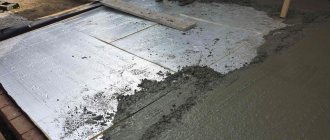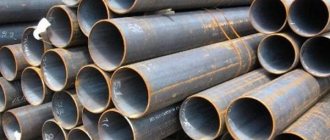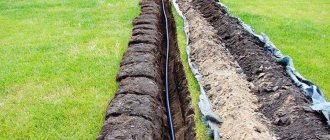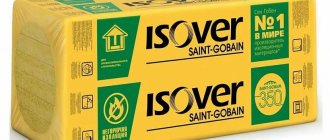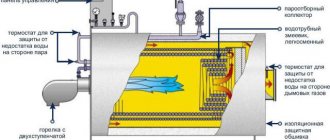Unfortunately, we live in an area where we have to think about how to stay warm in winter. But this applies not only to people, but to everything that surrounds us on the farm. It is very important to know how to insulate a water pipe. If this is not done on time, then at some point you may be left without water supply in the house. And trying to carry out repair work in the cold season is not only unpleasant, but also quite labor-intensive. Let's take a closer look at how to insulate a water pipe with your own hands.
Primary requirements
Water pipe in the ground
Until a certain point in construction, materials were used that were at hand. But human needs and demands are becoming greater, so the approach to the components must be appropriate. If we talk about what kind of insulation should be used for pipes, here are the main requirements that apply to it:
- Durability. An important factor, because insulation is not carried out with a view to a year or two. This would require frequent excavation work, which is quite exhausting.
- Strength. If the pipe is in the ground, then there is sufficient pressure on it. If this is not taken into account, then the insulator will simply lose its elasticity and its effectiveness will be reduced to zero.
- Corrosion resistance. Exposure to external factors can be detrimental to some coatings, so either the insulation itself must have an inert layer, or care will need to be taken to have one.
- Heat capacity. It should be minimal. This means that the temperature of the insulation should not change when exposed to external factors.
- Ability to absorb water. It is desirable that the material has a water-repellent effect. This will make it possible to prevent the penetration of moisture from the soil or during precipitation. Otherwise, when it accumulates, the protective layer may be destroyed due to freezing.
- Fire resistance. This factor plays a very important role when used indoors, as well as in cases where the water supply is made of plastic pipes.
- Maintainability. It’s good if if any area is damaged, it can be replaced modularly, without involving the rest of the canvas.
- High temperature resistance. This indicator will be indispensable when it is necessary to supply hot water from the house to another room.
Must be able to withstand pressure
Why insulate water pipes
Pipes laid at shallow depths must be insulated.
Uninsulated water supply lines present a number of problems for cottage owners:
- Pipes located at shallow depths are prone to freezing along with the soil. The water in them will definitely turn into ice in severe frosts.
- The resulting lumps not only stop the system from working, which is extremely inconvenient for the family living in the house, but also often lead to a break in the line.
- An accident requires labor-intensive and costly repairs. We have to carry out excavation work, dismantle a section of the pipeline, and finance the installation of a new one.
Thermal insulation of water supply systems is especially important for residents of cold/northern regions, where the depth of soil freezing ranges from 1 to 2.5 m or more.
What can be used
In principle, any material listed below can be used to insulate water pipes. But the choice should fall on the one that is most suitable for specific conditions. It may not meet absolutely all the requirements listed above, and this is not always necessary.
Mineral wool and polyethylene foam
One of the options that has been used for quite a long time and is constantly being improved is mineral wool. There are several varieties of it. Glass wool is made from glass, about 35% (usually recycled glass containers, etc.), soda ash, sand and other additives. Therefore, it can be called quite environmentally friendly. Its positive aspects are:
- minimal thermal conductivity;
- ease of installation;
- light weight;
- ease of transportation;
- not food for rodents;
- protection from noise exposure.
The disadvantages include:
- poor resistance to moisture, which leads to loss of thermal insulation properties;
- the need to use personal protective equipment during installation;
- the fiber is easily damaged and breaks with little force applied;
- shrinkage may occur over time;
- instability to fire.
Basalt wool
A peculiar subspecies is basalt wool. It is made from crushed stone. In addition to all the advantages listed above, we can highlight resistance to high temperatures, as well as immunity to moisture.
Foam rubber
Foamed rubber is a synthetic product that appeared on the market not so long ago. It was developed specifically for insulating pipelines indoors and outdoors. Its characteristics:
- high elasticity;
- resistance to high temperatures;
- moisture resistance;
- ease of installation;
- vapor tightness;
- self-extinguishing when exposed to an open flame.
If we talk about the disadvantages, then this is most likely only the difficulty of delivery, because it takes up a fairly large volume and is light in weight.
Insulation for polyethylene foam pipes
Polyethylene foam is often used as a substrate for various floorings. But some of its types are designed specifically for pipeline insulation. The choice of masters falls on him because he:
- does not support the development of bacteria and fungi, which is very important for a humid environment;
- easy to install;
- has low weight;
- UV resistant;
- fireproof;
- does not require special installation skills.
With prolonged use, the material may shrink to a certain extent, which reduces its original performance. In addition, certain problems arise when sealing seams. It is very difficult to achieve a perfect fit in some cases.
Expanded polystyrene
Penoplex and expanded polystyrene have many similar properties. They are derivatives of the polymer component. This means that they practically do not interact with organic matter. These materials:
- are easy to install;
- are light in weight;
- have zero heat capacity;
- resistant to moisture;
- characterized by compressive strength.
At the same time, the products are very unstable to open fire. Rodents love to damage such insulation materials.
Foamed polyurethane
Polyurethane foam shells are products in the form of semicircles, which are put on like a cover on a pipe. Usually it is covered with a protective layer of waterproofing on top. They use it relying on:
- ease of selection for a specific diameter;
- lack of thermal conductivity;
- light weight;
- assembly in the form of a constructor;
- possibility of repeated use;
- the possibility of carrying out insulation work even in winter.
The downsides are: sufficient transportation costs, as well as a maximum temperature limit of 120°C.
Warming paint
A relatively new, but quite interesting development is insulation using special paint. Even a small layer of it has good insulating properties. If it is increased several times, then losses will be significantly reduced. This product:
- easy to apply on surfaces of any shape;
- has excellent adhesion to metal;
- not affected by salts;
- endowed with anti-corrosion properties;
- eliminates the formation of condensation;
- does not place additional load on the pipes;
- after coating, all valves or inspection units remain freely accessible;
- ease of repair;
- high temperature resistance.
Among the negative aspects, one can highlight the need for additional insulation in case of severe freezing of the soil or the external location of water supply pipes.
Advice from the experts
When performing installation work in a country house or in a private country house, be sure to pay attention to connections and fittings. They need better processing. If this moment is missed, condensation moisture will eventually become the number one problem. The threaded joints will freeze first and then destroy the entire system.
Pipes located in unheated rooms (ground floor, cellar, etc.) also require insulation. It is best to use Merilon here.
Do not forget about those areas of the pipeline that are located at the entrance to the house. Here, temperature changes - heat from the basement and cold from the street - are also unfavorable conditions for the normal functioning of the water supply system in cold weather. The entry in the foundation area can also be insulated with Merylon.
A well-installed water supply system will not cause any trouble to the owner of the house and will provide all residents with a continuous supply of water.
Insulation with mineral wool
The process of insulation with mineral wool
This method is more suitable for indoor use, as well as for above-ground street water supply. The sequence of actions will be as follows:
- The total material consumption is calculated. In addition to the cotton wool itself, you will also need waterproofing in the form of thick construction foil or ultraviolet-resistant polyethylene.
- The pipe needs to be treated well. To do this, it is cleaned, degreased and covered with enamel. This step is necessary so that the pipe under the insulation does not begin to collapse.
Mineral wool insulation schemeNext, you should prepare segments from one sheet. Their size should be such as to wrap the pipe once. The cotton wool must be laid so that it fits tightly to the plane. In this case, the required level of insulation will be ensured.
- Aluminum tape can be used to temporarily fix the insulation.
- The insulation also needs to be inserted into the holes where the pipe enters the wall; often this is where freezing occurs.
- After the entire area has been covered, you will need to provide protection for the cotton wool itself. To do this, it is wrapped in plastic film or aluminum foil. The sheets must be laid so that there is an overlap of 15 cm. This will prevent moisture from penetrating into the middle and destroying the insulation.
- For additional fixation, reinforcement is made using a nylon cord or steel knitting wire, which is applied like a snake to the entire pipe.
Mineral wool cylinders
If you use ready-made elements made of mineral wool, which come in the form of cylinders, then they are put on the pipe, and the joints are well glued using aluminum tape. To better insulate the faucet, you need to unscrew the handle from it. Cut a hole in the insulation for the fastening element. Put it on, and after that screw on the handle.
Material selection
*
Questions about how to insulate a metal or plastic water pipe on the street, what materials are cheaper and what free options are available are what are primarily of interest to those who independently build or maintain their home. When choosing insulation, it is important to understand that using highly specialized materials is more convenient, but they are a little more expensive. First of all, let's look at free insulation options.
Free insulation for external water supply
One of the cheapest, and for many people completely free, insulation is sawdust. Their use allows you to minimize the cost of insulation, but complicates the process a little, because To insulate the water supply from the cold using sawdust, you will need to additionally make a box into which they are poured.
Sawdust
Manure can be used as free insulation for water pipes. During the process of rotting manure, a large amount of heat is released. It can not only protect the water supply from the cold, but also warm it up a little. As with sawdust, manure requires an additional box.
In some cases, slag is used as insulation. It is porous, contains a large amount of air and does a good job of protecting the pipeline from freezing. In private houses where individual heating boilers are installed, slag is available in sufficient quantities, so using it you can not only minimize the cost of insulation, but also save money, because Removing slag requires certain costs.
Insulation with foam rubber
Advantages of foam rubber
This material, like the previous one, can be produced in sheet modification and ready-made tubes. The advantage of the first option will be the ability to independently select the thickness of the insulation for any pipe. In many ways, the installation is similar to what was described for mineral wool. The difference is:
- Possibility of installation not only on the surface or indoors. The material tolerates staying in the ground very well. But at the same time, it will definitely need to be additionally wrapped in plastic film.
- In order to better fix the sheets wrapped around the pipe, you can use special glue or double-sided tape. A piece of the required length is measured and cut. It wraps around the pipe. The ends are coated with the compound, after which they are pressed tightly until they set. Individual elements can be fixed together in the same way. In this case, you will get a monolithic structure. For greater reliability, you can also use aluminum tape.
- When using ready-made tubes when passing corners, it is necessary to create a small seal in the place where it will bend. If you do not do this, the wall may stretch and its thickness will be less, which will increase the likelihood of freezing.
The following video shows the technology of thermal insulation of pipes with foam rubber:
Electric cable
It is worth mentioning separately about the electrical cable. It allows you to insulate a water pipe so that it does not freeze, above the ground and in the ground. The cable is distinguished by the fact that it is able to turn on independently at a temperature of +3 degrees and turn off independently when the temperature drops. But subject to installing a thermal relay. Otherwise, the self-regulating cable will draw a lot of electricity.
Electric insulation is especially good for regions with harsh winters or for those areas where rocky terrain does not allow pipes to be laid below the ground freezing level.
Interesting: DIY plumbing in a private house
Penoplex insulation
Penoplex
When using this material, the least amount of time will be spent. This, like the previous method, can be used for pipes that are laid in various conditions. The degree of moisture absorption is minimal. This means that penoplex can be in the ground without harming it. Products made from it are usually the so-called shell. These are two half cylinders. In order for them to fit together well, a special tongue-and-groove lock is provided at the ends. The radius of the inner circle is equal to the outer one on the pipe for which the specific sample is intended. During installation, they can be coated with suitable glue or reinforced tape. In this case, there is a guarantee that moisture will not seep inside and destroy the pipe.
Heating
When planning the installation of winter water supply, you need to keep in mind that insulation only helps reduce heat loss, but cannot provide heat. And if at some point the frost turns out to be stronger, the pipe will freeze. Particularly problematic in this sense is the area where the pipe leads from the underground sewer into the house, even a heated one. Still, the soil near the foundation is often cold, and it is in this area that problems most often arise.
If you don't want to freeze your water supply, heat the pipe. For this, a heating cable or heating plates are used, depending on the diameter of the pipes and the required heating power. Cables can be laid lengthwise or wound in a spiral.
Method of attaching the heating cable to the water pipe (the cable should not lie on the ground)
A heating cable is good for everyone, but it’s not so rare that our electricity goes out for several days. What will happen to the pipeline then? The water will freeze and may burst the pipes. And repair work in the middle of winter is not the most pleasant experience. That’s why they combine several methods - they lay a heating cable and insulation on it. This method is also optimal from the point of view of minimizing costs: under thermal insulation, the heating cable will consume a minimum of electricity.
Another way to attach a heating cable. To reduce your electricity bills, you also need to install a heat-insulating shell on top or secure roll insulation
Laying a winter water supply system in a dacha can be done using the type of thermal insulation shown in the video (or you can take the idea and do something similar with your own hands).
https://youtube.com/watch?v=ZjBKrFVWbE8
Insulation with paint
Some paints can be applied over rust
It seems that scientists have finally managed to develop a unique method that requires minimal time, effort and money. But it’s worth mentioning right away that for pipes that are laid on the surface or above ground freezing, this option is more likely to be an additional solution than the main one. If such paint is used, it will be possible to reduce the thickness of the main insulation. In order to treat the surface, you will need to do the following:
- Before opening the container, it is necessary to check the integrity of the seals. This will guarantee that the material arrived in factory quality.
- The consistency of the composition is such that the liquid base sinks to the bottom, and the solid component rises to the top. Therefore, before starting any work, it is important to mix. If it is carried out using a mixer or drill, then the speed of the tool should not exceed 150 per minute. You need to move the nozzle not only in a circular motion, but also in a reverse translational motion.
- If the paint has been standing for a long time, it can be diluted with distilled water.
- Application to the surface can be done with an ordinary brush or a special sprayer. If you use the latter, it is important to ensure that all modules will have no filters. This is very important to do, because... the paint contains small spheres, which are the secret component. If they pass through the mesh, they will be destroyed, which will turn the composition into ordinary facade paint. Spraying should also be carried out at a pressure not exceeding 8 atmospheres.
- Some paints can be applied directly to rusty surfaces. This will avoid preparatory work.
Note!
If the liquid has stood for more than 5 minutes without being used, then it must be stirred again for a few seconds until a homogeneous mass is formed.
Important conditions for laying underground water supply
Prerequisites for water freezing in pipes arise even at the stage of installation of external water supply. Construction rules directly indicate that the depth of underground water supply lines must be below the standard freezing point of the soil.
For our northern country in most regions this value exceeds 1.2 meters . You usually don’t want to dig such a deep trench and take it as a truth (hope) that the soil does not freeze to such a depth, and as a result, the water supply is placed at a depth of half a meter, thereby making a grave mistake. One winter, the water in it will definitely freeze. And digging frozen soil in winter... Draw your own conclusion.
Freezing depth by region.
Attention! Here it must be said that the concept of soil freezing is not the annual formation of permafrost to a depth of one and a half meters, but a temporary decrease in soil temperature to a negative value.
Heating cable
Self-regulating cable
The use of an active heating system brings with it a huge number of advantages. Thanks to it, it becomes possible not only to prevent freezing, but also to defrost an area that has already been subject to it. You need to choose from two main types of such products:
- self-regulating cable;
- resistive cable.
Each of them has a number of advantages over the other. The first conductor operates completely automatically. Its design implies varying degrees of heating in a certain area. This is due to how the internal layer between the cores is arranged. When the temperature is low, resistance drops and heating increases, and vice versa. Such a wire can be laid even on an uneven area, and its performance will not be affected in any way.
The resistive cable has a constant heating temperature, so uniform heating of the entire area can be ensured. It requires more attention during operation, but its cost is significantly lower than the previous option. By design, it can be with one core or two. The second one is easier to install.
Resistive single-core
There are two main ways to install the cable:
- Interior. In this case, the conductor is placed directly into the pipe and, in contact with water, prevents it from freezing.
- External. The cable is located along the outer contour. For such options, a wire with a flat configuration is usually selected, since it is more difficult to damage and takes up less space.
Products have different power densities, which is also important to calculate correctly. In the first installation option, they usually stop at a value of 10 W/m. In order for a cable located outside to have the required efficiency, two basic rules must be followed:
- for pipes with a diameter of up to ¾" a capacity of 17 W/m will be required;
- for diameters from ¾" to 1½" - 27 W/m.
Higher power is also available, which can reach 31 W/m, but such values are usually used to prevent damage to sewer pipes that have a diameter of 110 mm or more.
Connecting the heating cable
If you decide to carry out external installation, then you should proceed as follows:
- A place is determined where the cold cable can be powered.
- A separate machine is mounted in the power panel. The rated withstand current should be less than that of the main one.
- A conductor is laid from the machine to the installation site of the thermostat. It is important that its cross-sectional area is sufficient for the heater power.
- Using a hammer drill or drill, a box is mounted on the wall where the thermostat will be located. It is better to place it indoors. This will allow for faster setup and will also eliminate operational failures.
- Next, a hole is drilled in the wall through which the heating cable is laid. There is no need to connect it yet; it is enough to leave a certain part indoors.
- The pipe must be painted and also degreased.
Installation of heating cable outsideThe conductor can be laid along the pipe in a straight line, or it can be wound like a snake. The second option is more effective, but will require a longer cable length. You will need to make a figure 8 loop around the tap.
- In order to fix the material on the pipe, you will need aluminum tape. It can be used with periodic arrangement. If the heating cable is laid in a straight section, then it must be completely covered with adhesive tape.
- It will also be necessary to connect a temperature sensor to the supposedly coldest section of the pipe if a resistive cable is used. The wire from it is connected to the thermostat.
- From above, the entire surface is covered using one of the types of external insulation.
- If a single-core resistive cable was laid, then it is necessary to return the second end in order to loop the entire network, or stretch the cold cable to the second edge.
- Once everything is in place, you can begin connecting the power. The circuit will be the same for two types of conductor. The first step is to remove the outer insulation. This should be done approximately 6–10 cm. The shielding braid is gathered into a bundle or the drainage core is trimmed. The insulation for the conductive cores is removed. One of them is shortened by 1 cm compared to the other. Two pieces of heat-shrinkable tubing are placed on the main cable. One should be of such a diameter that 2 cores fit into it, and the other - so that 3 can fit in. One more piece is put on each core. Using metal sleeves, one core of the cold cable is connected to the core of the hot cable. Sealing is carried out using a heat-shrinkable tube. The same procedure is performed for the second element. The cambric is pulled over the top and compacted using a lighter or hair dryer. A ground connection is made with the shielding braid. The thermotube is also shrinked. And the final step is to place all the connections together inside the last piece of tube.
- The cold cable is connected to the thermostat. The signal wire from the sensor is also connected to it.
Sealing a self-regulating cable
In a self-regulating cable, it is important to take care of high-quality sealing of the second end. To do this, a heat-shrink tube is put on it, heated with a hairdryer, and the end is tightly compressed with pliers.
Note!
For conductors with independent temperature adjustment, special thermostats are produced that are already built into the cold cable. They turn on when the lower limit reaches +5°C, and turn off at +15°C. All you need during assembly is to connect them together and plug them into a power outlet. There is no need to purchase additional modules.
Internal installation of heating cable
Internal installation can also be done independently. For these purposes, all the necessary adapters are usually included with the cable. You can also easily purchase them yourself. The process will be like this:
- A convenient place is selected to insert the conductor into the pipe.
- The first step is to install a tee through which the dive will be carried out.
- The end of the conductor that will be inside must be well sealed. To do this, the top insulation is removed by 1 cm. The shielding braid is collected into a bundle and bit off using side cutters. A 6 cm long heat shrink tube is cut off. Half of it is put on the wire, heated with a hairdryer, and the protruding part must be compressed using pliers. A special silicone plug is put on top, and again everything is secured using heat-shrinkable cambric.
- The conductor is passed through a fixing sleeve, a silicone seal, 2 metal washers and a clamping nut. It fits into the pipe.
- The part required for connection is left on the surface.
- A locking mechanism is clamped into the tee.
- The connection to the electrical part is carried out in the same way as described above.
Installation diagram inside the pipe
Note!
It is imperative to take care of high-quality grounding. If this is not done, then the slightest breakdown can cause serious harm to any of the residents of the house. Additionally, you can think about installing an RCD. This device will detect the slightest leak and stop the power supply.
Heating cable entry
Video
Protection of insulation from negative factors
Protection against freezing of a water supply system located in the ground has its own specifics. The material should not completely or partially lose its thermal insulation properties under the influence of external factors.
Re-insulating or repairing the outer layers requires expensive and time-consuming excavation work, so immediate care must be taken to maintain the integrity of the protective structure.
Destructive effects of earth and water
The underground water supply system experiences soil pressure, so the material used for insulation may be crushed. This can significantly increase its thermal conductivity. To prevent such developments, it is necessary to create a hard outer shell using larger diameter pipes or special trays.
Mineral wool is hygroscopic and can be crushed with a little finger effort, so the layer of earth will compress the material and it will lose its low thermal conductivity property
In the case of using hygroscopic materials as thermal insulation of pipelines, it is necessary to prevent the possibility of influence of groundwater on them, which is always located in the ground, regardless of the degree of water saturation of the soil.
To protect mineral and glass wool, additional means of protection are used - plastic pipes larger than water pipes, which at the same time solves the problem of insulation collapse.
You can also use the following materials to create a waterproofing shell:
- rolled aluminum foil;
- reinforced (plumbing) tape;
- roofing felt;
- high density polyethylene film.
Polystyrene foam and extruded polystyrene foam weakly absorb moisture, but over time they also become unusable with constant defrosting. Foam glass, polyurethane foam, and heat-insulating paint are completely unaffected by wrinkles and moisture.
Protecting objects located in the ground from moisture using roofing felt is a long-used, but not the most practical option.
Solving the problem of insects and rodents
Another cause of damage to the insulation of the water supply system can be rodents and insects. Ants gnaw numerous passages in the thermal insulation that is attractive to them, and mice use it to build a nest. These actions expose parts of the pipes, which negatively affects the quality of insulation.
Neither insects nor mice can spoil polyurethane foam or foam glass, but they do an excellent job with basalt wool. It and similar materials for external insulation of water supply pipes must be protected from rodents if they are located at a depth of less than 2 meters. Earth ants do not penetrate below 1 meter, while forest ants build a large anthill, the above-ground part of which is impossible not to notice.
To protect against rodents, you can wrap the insulation with a fine-mesh metal mesh. To prevent access not only to mice, but also to ants, it is necessary to wrap the material with aluminum foil, reinforced tape, or use plastic pipes or trays of any shape as the outer shell.
A shell made of polyurethane foam or foam glass can withstand soil pressure, exposure to moisture in the ground, and cannot be damaged by rodents and insects
Other ways to prevent freezing
Another method that is successfully used in areas where the winter temperature drops below zero to critical values. It is called the umbrella or air gap method. Its essence lies in the operation of physical laws. The temperature underground will always be higher than outside in winter. In order to use this useful property, a larger diameter pipe is first laid, which will serve as a sleeve. The one that will serve as a highway is placed in it. The trench is filled with soil. The layer that remains between the two pipes will compensate for the temperature difference and prevent freezing.
Pipe in pipe
High blood pressure can also help in such a situation. The usual pressure value for a household network is 2 atmospheres. Water stops freezing at 4 atmospheres. On a section of pipe that will be located at negative temperatures, it is necessary to ensure this level. To do this, a special storage device and a supercharger are installed on one of its parts. A gearbox is mounted at the other end, which will prevent damage to household appliances.
Alternative thermal insulation options
There are alternative methods of thermal insulation that prevent adverse consequences. They do not apply in all cases. First, you can remove all the water from the system - no water, no problem. This method is applicable for houses not used in winter. It will help protect the system from damage if water pipes freeze.
Secondly, you can ensure constant movement of water in the pipeline by opening the tap a little. This is not difficult to do if you live permanently. But the option is dangerous - suddenly you will have to leave home for a couple of days, and upon return you will be surprised in the form of a damaged water supply.
The insulation helps get rid of condensation, which has a positive effect on extending the service life of metal pipes
In addition to holding the tap slightly open, there are other ways to ensure constant pressure in the pipeline. For example, use a special pump to increase the water pressure in the system or add another element - a receiver. It should be cut into the pipe immediately near the pump. The operation of the receiver will maintain constant pressure, which will protect the system from freezing.
Glass wool
Those who have been involved in repair and construction work for a long time remember glass wool. It is still used at construction sites for both thermal insulation and sound insulation. The option, of course, is quite cheap, but do not forget that this material penetrates into clothing and then into the person himself, causing severe itching and painful sensations. Today, glass wool is sold in strips or slabs that are wound into a roll. It is for this reason that glass wool has gained particular popularity among builders.
Glass wool
It is worth adding that this insulation has a relatively low density, therefore, it is better not to use it without additional insulators. After the pipe is insulated, roofing material or fiberglass should be placed on top.
Return to content
How to find out the temperature of the coolant in the batteries
When doubts arise about the quality of the heating services provided, and the inhabitants of the apartment simply begin to freeze, measures should be taken to determine the cause. To do this, measure the temperature:
- air in the room;
- pipes;
- batteries;
- coolant - water in the heating system.
The data obtained will help you understand whether the room is really unreasonably cold or whether it is just a subjective feeling.
It must be taken into account that independent measurements of heating indicators are not direct evidence of violation of standards. However, they can serve as a basis for filing a complaint and inviting representatives of the service organization for control measurements
Determining the water temperature in the central system
It should be noted that reliably measuring the temperature of the coolant in a central heating system is not so easy. The most accurate indicator remains only the air temperature in the room. However, you can do the following:
- Open the tap if it is installed on the radiator in the apartment.
- Place a container under it, after placing a thermometer there.
- Collect water.
- Wait for the final thermometer reading.
This indicator must comply with the described standards, but upward deviation from them is also allowed. The maximum temperature deviation is up to 4 °C.
In addition, if air is detected in the heating system of the apartment, you should contact the service organization.
Determining hot water indicators
There is another way to establish the truth, related to the fact that the temperature of the heating batteries in the apartment and the hot water supply are directly related. Therefore, it is advisable to measure the water degree like this:
- Open the hot tap.
- Wait 3 minutes for the water to heat up to maximum.
- Take a container and place it under the stream without closing the tap.
- Place the thermometer in the center of the container.
- Wait for the final readings from the device to be received.
If the device shows a number from 60 to 75 °C, everything is normal with the coolant. If the temperature data is lower, it is possible that the water in the heating system is not heated enough.
